|
Jul
19
2021
|
|
Posted 4 years 183 days ago ago by Admin
|
|
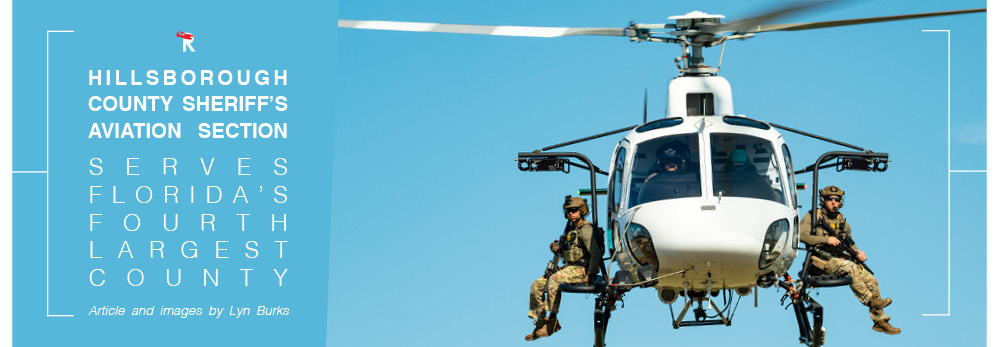
WATCH VIDEO FEATURE
I bet if you were to ask where Hillsborough County, Florida, is located, most people couldn’t point to it on a map. However, if I asked about cities like Tampa and St. Petersburg there would be instant recognition. Although it may lack in name recognition, this fourth largest county in Florida is rich in history and progressively serves its 1.4 million citizens and seasonal visitors on many fronts.
The 1,266 square mile county was established in 1834 and was named for Wills Hill, the Earl of Hillsborough, who served as British Secretary of State for the Colonies from 1768 to 1772. It should be noted that I found an interesting historical tie to aviation in my research.

Did you know that Hillsborough County was home to the world’s first scheduled airline service, which was founded by Tom Benoist who signed the world’s first airline contract on December 17, 1913 and began operations on New Year's Day 1914. The St. Petersburg-Tampa Airboat Line began flying passengers and cargo on the 23 mile leg from St. Petersburg to Tampa using flying boats. In 1914 depending on means of travel: the trip from St. Petersburg to Tampa could be 2 hours by boat, 20 hours by car, or 4 to 12 hours by train. However, by flying boat, the travel time was about 23 minutes.
50 YEARS OF LE AVIATION SERVICE
Presently based at the Tampa Executive Airport (KVDF), the Hillsborough County Sheriff’s Office (HCSO) Aviation Section began serving the county in the early 1970’s utilizing the Schweizer helicopter as a patrol aircraft and various airplanes which included a Dehavilland Beaver and a twin engine Piper Aztec. In 1982 the unit acquired a Bell 206 Jet Ranger that was later equipped with a FLIR Mark-II Forward Looking Infrared camera system, one of the first Law Enforcement FLIR systems in the country. The Bell 206 was a multi-mission aircraft as it was used for both EMS transport and to support law enforcement operations.

At one time the unit had three Schweizer 269A helicopters, a Bell Jetranger and a Cessna 206 airplane. In 1995 the airplane was phased out and the unit began transitioning to the military surplus Bell OH-58 helicopters. In 1997 the aviation section relocated to its current facility (also on KVDF) known as the Sheriff David Gee Aviation Complex. Fixed-wing operations were reintroduced in 2004 and are still in operation today.
In the late ‘90s the unit began to upgrade their aircraft to modern forward looking infrared (FLIR) technology for night surveillance operations. At the turn of the century, the unit set about on another modernization strategy to upgrade its military surplus fleet to the Airbus AS350.
Today, the aviation section fleet consists of four Airbus AS350 helicopters and one Cessna 208 Caravan which is supported by eight line pilots, one flying sergeant, and two maintenance personnel.
DIVERSE CAPABILITIES
“In addition to serving the citizens of, and visitors to, Hillsborough County, we’re also tasked with supporting our federal, state, and local agency partners as the response unit for the Region 4, Regional Domestic Security Task Force (RDSTF),” said Jeramy Butler, HCSO master sheriff’s pilot.
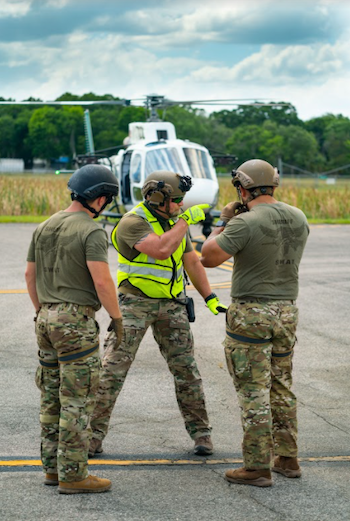
This commitment to the RDSTF, as well as the citizens of the county, requires a high level of capability and training from the HCSO Aviation Section team members. From a law enforcement mission equipment perspective, one would be hard-pressed to find an aircraft any more prepared or outfitted than HCSO’s. Their newest AS350 variant is the very capable B3 which is complimented with the FLIR SAFIRE® 380-HDc, which is known for its unparalleled stabilized HD multi-spectral imaging in a compact, low-profile package that is perfect for law enforcement operations. In addition to the FLIR for use in night operations, all aircraft are night vision systems (NVIS) capable, and all pilots / TFOs are NVG trained and operational.
In fact, when it comes to operating at night, in 2020 the HCSO Aviation Section’s efforts and contributions to public safety were recognized at the Airborne Public Safety Conference (APSCON) Forward-Looking Infrared (FLIR) Vision Awards. The competition compares state and local law enforcement agencies from across the country in their use of tactical airborne thermal imagery.
HCSO's skillful pilots and crews were among the top contenders and won second place for "K9 Catches" and placed third in the category of "Best FLIR Video." The honor came with a $1,000 prize donation to HCSO's Lynn Sowers Foundation.

"Our aviation team is one of the best in the country and these prestigious awards reflect its professionalism and dedication," said Sheriff Chad Chronister in a previous press statement. "Their passion to serve the people of Hillsborough County is on display every single day, every time they takeoff, until they land, and we could not be prouder of this great achievement."
Given that much of Hillsborough County, and many of its neighboring partner counties, are surrounded by water, parks, forests, and recreational areas, they may also be called on to perform firefighting and search and rescue operations. This level of capability is not typical of airborne law enforcement agencies.
For firefighting missions the unit relies on a 144-gallon Bambi-Bucket system which allows the team to pull water from small sources in remote locations in order to quickly get water onto a fire. The aviation section has also hosted several multi-agency aerial fighting training events at the Hillsborough County’s Sheriff’s Walter C. Heinrich Practical Training Facility in order to make multi-agency firefighting ops safer in their region. These training events have been attended by organizations like the National Guard, Florida Division of Forestry, City of Tampa Police, and Citrus County Florida.
In the event that a patient needs to be accessed or extracted from a remote location such as over water or in a swamp, the unit relies on its Goodrich hoist system to get the job done. When a search and rescue call is activated and the hoist will be required, the tactical flight officer (non-flying pilot) will reposition to the back of the helicopter in order to operate the hoist. Additionally, depending on the type of call, the mission may require a rescue specialist to accompany the aircraft. In these cases, the aviation section may rely on such partners as SWAT, Special Incident Response Team (SIRT), or Hillsborough County Fire Rescue to provide those personnel with the specialized training required to operate in and around the helicopter during rescue operations.
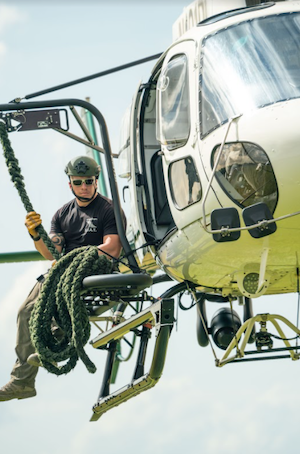
Although helicopter operations make up the majority of the 2,000 hours the unit flies annually, they are not relegated to only helicopter ops. In addition to the four helicopters, they also fly a Cessna 208 Caravan airplane as well. The strutted, high-wing 208 typically seats nine passengers in its unpressurized cabin, is powered by a single Pratt & Whitney Canada PT6A tractor turboprop and has a fixed tricycle landing gear. HCSO fixed-wing operations can include surveillance, administrative flights, and disaster relief.
CRAWL, WALK, RUN
During our visit with HCSO, the aviation section was performing a very specialized, multi-day joint training event with the SWAT team in which they were utilizing the helicopter for rapid SWAT team insertions. The three types of insertions practiced were skid landing, skid light landing, and fast-rope insertions. During the training event there were two levels of team members to be trained, one-third of the members were new to SWAT and this training was their initial introduction to helicopter insertions. The remainder of the team were completing their recurrent training in order to maintain proficiency in all three insertion techniques, as well as operating in and around the helicopter.
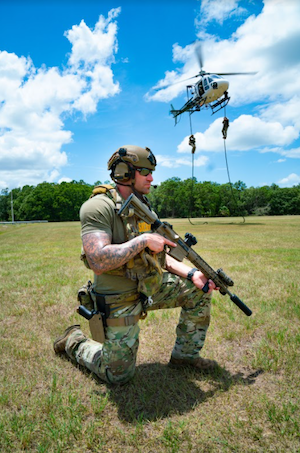
Fast-roping, also known as Fast Rope Insertion Extraction System (FRIES), is a technique for descending a thick rope. It is useful for deploying personnel from a helicopter in places where the helicopter itself cannot touch down.
The benefit to this technique is that because team members are not connected to the rope, team members can be rapidly inserted by sliding down the rope. There’s virtually no margin for error. If a team member loses his or her grip, or uses the wrong technique, they could fall. Of course, it can also be said that given the high-risk situations that these specialists may be placed into (active shooter), the relative risk of a fall may be viewed as low.
According to Master Sheriff’s Pilot Jeramy Butler, this capability was developed following an active shooter incident. HCSO SWAT identified that these insertion techniques would enhance the agency’s ability to rapidly insert a mitigating force very close to an active shooter scene or a potential domestic terrorist situation (e.g., 2021 Super Bowl LV at Raymond James Stadium in Tampa).
Butler describes the training as “crawl, walk, run.” He goes on to say, “because of the hazards, risks, and complexity of these operations, the training has to start off very slowly and will evolve into a more fluid, fast-paced, scenario-based evolution as proficiency is gained over the three-day event.”
The first phase of training occurs in the classroom where the teams discuss gear, communications, and safety in and around the helicopter. The second phase involves static training in the hangar, where initial fast-roping skills are honed from a 20’ fork-lift platform, in a quiet, hazard free environment, under the watchful eye of unit instructors.
In Phase Three of training, team members move just outside the hangar and begin operating from the actual helicopter. Utilizing the Tyler tactical bench attached to the helicopters as the primary platform, each team member is deployed multiple times in groups of two using all three techniques of insertion to include skid landing, skid light landing, and fast-rope deployment. Again, in an effort to keep things slow and safe, initial fast rope deployments start off low at approximately 15 feet and gradually increase over time.
On Day Two of the event when the entire SWAT team (rookies and veterans) convene, they started off in a semi-circle around the helicopter in order to brief the operations and emphasize safety points with the instructors and pilots. Once the engines go hot and the rotors start turning, the teams will get fully kitted out (weapons, body armor, radios, and special equipment) and perform many variations of the three insertion techniques with the pace of operations increasing as the day goes on. The addition of the kit adds a level of realism and difficulty as typically the gear can weigh 40 to 60 pounds.

The skid landing and skid light insertions are fairly straight forward. The team members ride the Tyler bench from takeoff to landing and rapidly deploy upon touchdown of the aircraft. Fast-rope ops are an entirely different animal altogether and take a great deal of coordination between the pilot, crew chief, and fast-roping team members.
As the aircraft approaches the X (insertion spot), the pilot and crew chief are communicating to ensure the aircraft is over the X and that the team members can safely fast-rope to the ground. This is especially critical when operating over confined, or elevated areas such as rooftops.
Once the pilot comes into a stabilized high hover over the insertion location, the pilot verbally communicates with the crew chief to deploy the team. The crew chief will then use hand signals in a chopping motion to command the team members to unhook from the Tyler bench and slide down the rope. The team members primary job is to smoothly transition from the bench onto the rope, and do their best to look at one another and slide down the ropes in unison. If not performed properly, it can put the aircraft out of balance and require the pilot to make larger control inputs in order to keep the aircraft stable and over the X.
SAFETY PAUSE
Day Two of the event was a long and hot day with dozens of operations occurring between two helicopters and multiple teams. One of the pinnacle, scenario based operations, for which the teams were building up to, was to be successfully deployed onto the small rooftop of a three-story shoot house, make entry into the building, and mitigate a threat using lethal force. The original plan was to perform this complex, fast-paced mission near the end of Day Two. However, when the unit instructors, crew-chiefs, and pilots came together to perform a risk assessment, it was decided to put the operation off until Day Three of training. Considering the length of the day (7 hours to that point) and the unseasonable high heat for which the team members had been wearing full body armor, it was recognized that fatigue could likely become a risk factor during one of the most complex and high-risk training operations up to that point.
I was present during that meeting when I heard one of the senior SWAT instructors say that there’s no training operation worth risking the injury of a team member because of something that can be controlled, like fatigue. The very next morning, with rested teams and pilots, the pinnacle training evolution went off without a hitch.
Personally, having flown with many law enforcement aviation units, I was impressed with the professionalism, capability, and efficiency of the unit. It’s a testament to not only the aviation section’s pilots, mechanics, and team members, but to the unit’s leadership as well.
“As a law enforcement pilot, I am honored to serve the citizens of the county, thankful for the support of Sheriff Chad Cronister, and proud of our entire team who keeps our aviation section running smoothly and safely,” said Sergeant Jason Doyle, chief pilot for Hillsborough County Sheriff's Aviation Section.
I agree, sergeant, the HCSO Sheriff’s Aviation Section has a lot to be proud of.
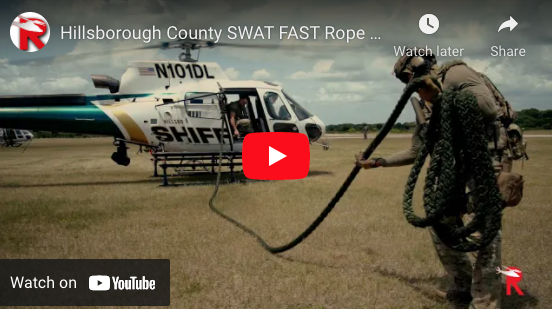
WATCH VIDEO FEATURE